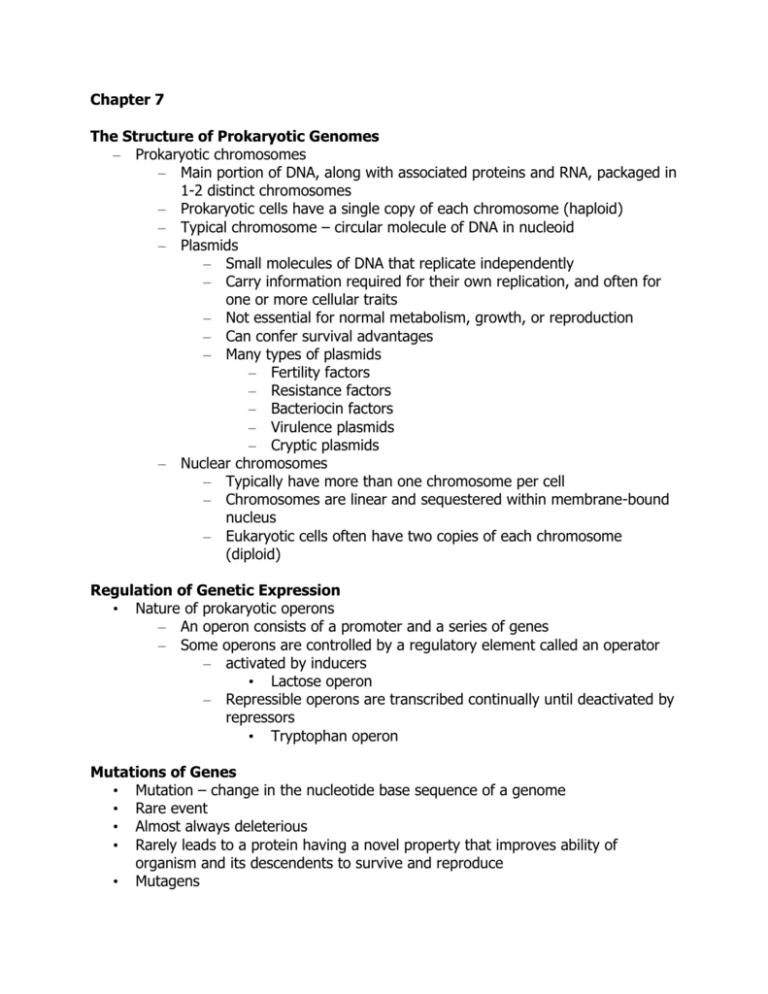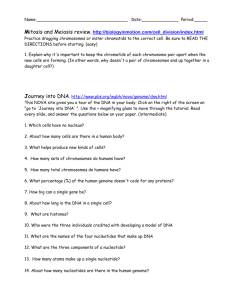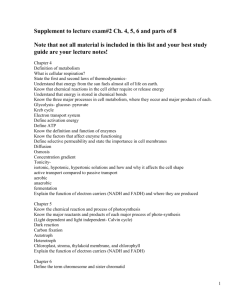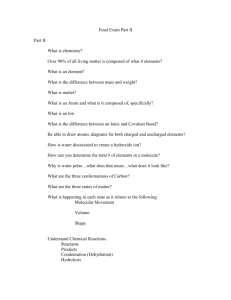Ch 7 Notes
advertisement

Chapter 7 The Structure of Prokaryotic Genomes – Prokaryotic chromosomes – Main portion of DNA, along with associated proteins and RNA, packaged in 1-2 distinct chromosomes – Prokaryotic cells have a single copy of each chromosome (haploid) – Typical chromosome – circular molecule of DNA in nucleoid – Plasmids – Small molecules of DNA that replicate independently – Carry information required for their own replication, and often for one or more cellular traits – Not essential for normal metabolism, growth, or reproduction – Can confer survival advantages – Many types of plasmids – Fertility factors – Resistance factors – Bacteriocin factors – Virulence plasmids – Cryptic plasmids – Nuclear chromosomes – Typically have more than one chromosome per cell – Chromosomes are linear and sequestered within membrane-bound nucleus – Eukaryotic cells often have two copies of each chromosome (diploid) Regulation of Genetic Expression • Nature of prokaryotic operons – An operon consists of a promoter and a series of genes – Some operons are controlled by a regulatory element called an operator – activated by inducers • Lactose operon – Repressible operons are transcribed continually until deactivated by repressors • Tryptophan operon Mutations of Genes • Mutation – change in the nucleotide base sequence of a genome • Rare event • Almost always deleterious • Rarely leads to a protein having a novel property that improves ability of organism and its descendents to survive and reproduce • Mutagens • • Radiation • Ionizing radiation – induces breaks in chromosomes • Nonionizing radiation – induces pyrimidine dimers Chemical Mutagens • Nucleotide analogs – disrupt DNA and RNA replication and cause point mutations • Nucleotide-altering chemicals – result in base-pair substitution mutations and missense mutations • Frameshift mutagens – result in nonsense mutations Genetic Recombination and Transfer • Exchange of nucleotide sequences often mediated by DNA segments composed of homologous sequences • Recombinants – cells with DNA molecules that contain new nucleotide sequences • Vertical gene transfer – organisms replicate their genomes and provide copies to descendants • Horizontal Gene Transfer Among Prokaryotes • Horizontal gene transfer – donor cell contributes part of genome to recipient cell • Three types • Transformation • Transduction • Bacterial conjugation • Transformation • Transforming agent was DNA; one of conclusive pieces of proof that DNA is genetic material • Cells that take up DNA are competent; results from alterations in cell wall and cytoplasmic membrane that allow DNA to enter cell • Transduction • Generalized transduction – transducing phage carries random DNA segment from donor to recipient • Specialized transduction – only certain donor DNA sequences are transferred







